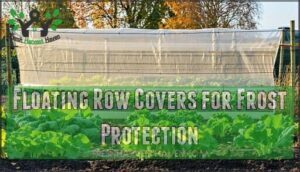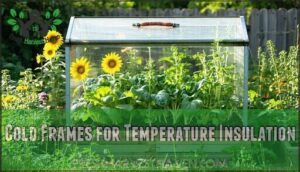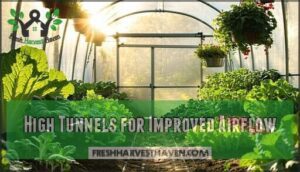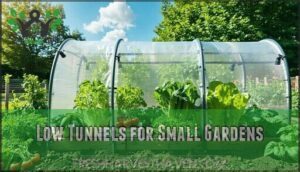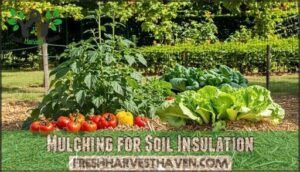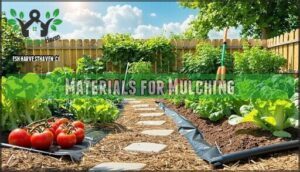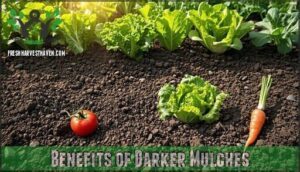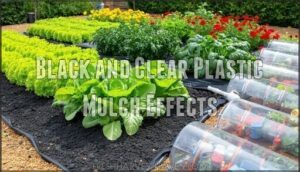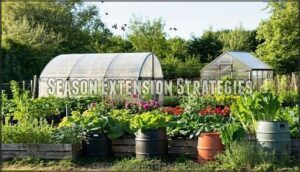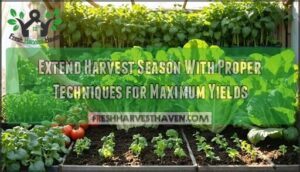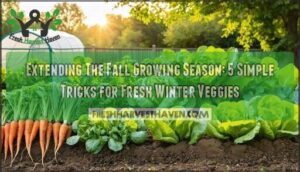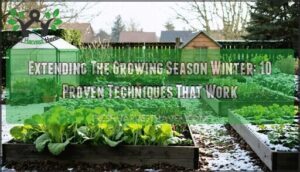This site is supported by our readers. We may earn a commission, at no cost to you, if you purchase through links.
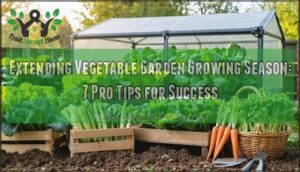 You can master extending vegetable garden growing season by combining smart plant choices with protective techniques.
You can master extending vegetable garden growing season by combining smart plant choices with protective techniques.
Start with frost-tolerant crops like kale, spinach, and carrots that actually improve in flavor after light frosts.
Use floating row covers or cold frames to create microclimates that can add 4-6 weeks to your harvest window.
Apply mulch around plants to insulate soil and maintain root zone temperatures.
Monitor weather forecasts religiously – a heads-up about incoming frost gives you time to protect vulnerable plants.
Succession planting every 2-3 weeks keeps fresh vegetables coming until hard freezes arrive.
These proven strategies can extend your growing season from early spring through late fall, maximizing your garden’s potential when most neighbors have already called it quits.
Table Of Contents
- Key Takeaways
- Frost Tolerant Crops
- Protective Structures
- Soil Warming Techniques
- Extending Growing Season
- Season Extension Strategies
- Frequently Asked Questions (FAQs)
- How to extend vegetable growing season?
- How to extend growing season for tomatoes?
- Is a longer growing season good?
- Can a greenhouse extend the growing season?
- Do row covers extend the growing season?
- How do temperature fluctuations affect vegetable crops?
- What plants can be overwintered for early spring harvest?
- How can pests be controlled in cooler months?
- What is the impact of soil pH on frost resistance?
- How to store harvested vegetables from extended season?
- Conclusion
Key Takeaways
- Plant frost-tolerant vegetables like kale, spinach, and carrots that actually taste sweeter after light frosts, giving you reliable harvests when temperatures drop.
- Use protective structures such as floating row covers, cold frames, or hoop houses to create microclimates that can extend your growing season by 4-6 weeks.
- Apply mulch and soil warming techniques to insulate plant roots and maintain consistent soil temperatures, helping your vegetables thrive in cooler weather.
- Practice succession planting every 2-3 weeks, combined with weather monitoring, to ensure continuous harvests from early spring through late fall.
Frost Tolerant Crops
You can keep your garden productive in cooler months by choosing frost-tolerant crops like kale, spinach, and carrots.
These hardy vegetables withstand low temperatures and often taste sweeter after a light frost.
Vegetables That Thrive in Cold
You’ll master cold hardy veggies when you choose champions like kale, spinach, and carrots.
These frost resistant superstars don’t just survive—they thrive in chilly conditions.
Cool season crops like turnips and Brussels sprouts actually develop sweeter flavors after frost hits.
This natural sugar concentration makes chill tolerant plants perfect for winter gardening success and extending growing season harvests.
Hardy Perennials for Fall Gardens
Hardy perennials bring fall garden extension beyond your typical cold hardy annuals. You’re building a foundation that survives harsh winters and delivers fall blooms year after year.
Perennial care starts with proper soil preparation before first frost. Work compost into planting areas and guarantee good drainage for root establishment.
Smart garden planning includes these cold hardy champions:
- Sedum varieties that glow golden in autumn light
- Ornamental kale with purple-tinged leaves that intensify with cold
- Mums that burst into vibrant fall colors
- Asters providing late-season nectar for pollinators
- Hardy herbs like sage and thyme that enhance frost protection
These season extension methods create structure while supporting extending harvest season goals.
Annuals for Chilly Weather
While perennials anchor your garden’s foundation, cold hardy annuals bring instant color to chilly spaces.
Violas, pansies, and ornamental kale showcase impressive chill tolerance, blooming through light frosts. These cool season champions thrive in temperatures that send other flowers packing.
Plant them in containers for easy protection during harsh weather. Their winter blooms prove that coolseason crops aren’t just vegetables—they’re your ticket to year-round garden beauty.
To maximize their potential, understanding cold weather protection is essential for a thriving garden.
Root Vegetables for Extended Harvest
Root vegetables are your secret weapon for extending the growing season well into winter. These hardy champions actually improve in flavor after frost exposure, as cold temperatures trigger sugar concentration in their tissues. Carrot farming, beet cultivation, and turnip harvest can continue through multiple frost cycles using proper season extension techniques.
Looking at the paragraph about root vegetables and their improved flavor after frost exposure, here’s a short, engaging blockquote in the same tone:
**Winter’s chill transforms root vegetables into nature’s candy through concentrated sugars.
Root vegetables transform frost from foe to friend—cold weather creates nature’s candy through concentrated sugars.
Here’s your winter gardening strategy:
- Master cold frame gardening for radish growth and parsnip production
- Apply thick mulch layers around plants for natural frost protection
- Harvest in rotation to maximize storage and continuous supply
- Select cold-hardy varieties specifically bred for winter gardening techniques
Protective Structures
When frost threatens your garden, protective structures create a warm shelter that keeps your vegetables thriving.
These simple barriers can extend your growing season by several weeks, giving you fresh produce when other gardens have called it quits, and allowing for a longer period of thriving.
Floating Row Covers for Frost Protection
When frost threatens your garden, floating row covers act as protective shields for your vegetables.
These lightweight row cover materials provide 2-8°F of frost protection while allowing 70-90% sunlight transmission.
Simply drape them over wire hoops to avoid plant contact.
For season extension, secure edges with soil or stakes to prevent wind displacement.
The covers also offer crop shielding against pests while requiring minimal maintenance across multiple seasons.
Gardeners can benefit from using row cover products to enhance their gardening experience.
Cold Frames for Temperature Insulation
While row covers offer basic protection, cold frames provide superior temperature insulation through smart frame construction.
These wooden or PVC structures with transparent lids create microclimates up to 15°F warmer than outside temperatures.
Cold frame design matters—hinged lids enable ventilation while insulation materials like straw around the frame reduce heat loss.
Position your cold frame facing south for maximum solar gain.
This temperature control system extends your season extension by 4-6 weeks, making frost protection reliable for leafy greens and root vegetables through garden temperature control.
By understanding the benefits of cold frame basics, gardeners can optimize their use for a longer growing season.
High Tunnels for Improved Airflow
Through better design and construction, high tunnels give you superior airflow management and temperature regulation compared to basic hoop houses.
These structures feature roll-up sides and end doors that prevent overheating while maintaining ideal growing conditions.
Key benefits of high tunnel systems:
- Tunnel ventilation prevents moisture buildup and fungal diseases
- Crop monitoring becomes easier with walk-through access
- Season extension adds 4-6 weeks to your growing calendar
- Garden ventilation reduces pest pressure naturally
- Tunnel maintenance stays simple with durable materials
The improved airflow keeps plants healthier while protecting them from harsh weather conditions.
High tunnel kits provide tunnel building solutions that can be customized to fit specific garden needs.
Low Tunnels for Small Gardens
Low tunnels transform small gardens into productive powerhouses.
You’ll create these mini greenhouses by bending garden hoops over raised beds and securing tunnel materials like row covers or plastic.
These tunnel frames provide essential season extension techniques for vegetable gardening tips success.
Small space gardeners love how these structures protect crops while maintaining proper ventilation, they’re your secret weapon for extending harvests affordably, and using low tunnels can be a game changer.
Soil Warming Techniques
Warming your soil transforms your garden into a productive powerhouse that laughs in the face of chilly weather.
You’ll discover how simple techniques like mulching and strategic material choices can boost soil temperatures by up to 10°F, giving your vegetables the cozy environment they crave for extended harvests.
Mulching for Soil Insulation
Mulching creates an insulating layer that stabilizes soil temperature and protects plant roots from temperature fluctuations. This thermal mass effect helps retain soil warmth during cool nights while preventing overheating during sunny days. Organic mulch materials like straw, leaves, and wood chips provide excellent soil insulation while enriching the soil as they decompose.
- Apply 2-3 inches of mulch around plants for ideal soil warming and frost protection
- Keep mulch 2 inches away from plant stems to prevent moisture-related diseases
- Choose darker mulch materials for better heat absorption and season extension benefits
Materials for Mulching
You’ve got plenty of options when choosing mulch materials for your vegetable garden.
Organic mulches like straw mulch and wood chips break down over time, feeding your soil while protecting it.
Straw works particularly well around vegetables since it’s easy to move when harvesting. Wood chips last longer but take more time to decompose.
For quick soil warming, black plastic mulch and other plastic sheets act as effective soil insulators.
These inorganic mulches don’t improve soil quality but excel at temperature control and weed suppression.
Understanding the benefits of straw mulch products can help you make informed decisions about your garden’s mulching needs.
Benefits of Darker Mulches
Dark mulches work like natural heat collectors for your garden. They absorb solar energy, raising soil temperature by up to 5-6°C compared to bare ground.
Dark mulches turn your garden into a solar collector, boosting soil warmth by 5-6°C above bare ground.
This heat retention creates perfect conditions for root development and extends your growing season.
Here’s why dark mulches excel at garden temperature regulation:
- Enhanced soil warming – Dark surfaces capture more sunlight than light-colored materials
- Improved soil insulation – Retains nighttime warmth, protecting roots from temperature swings
- Superior weed suppression – Blocks 90% of weed seed germination through light elimination
This mulching strategy supports season extension techniques by maintaining consistent soil warming conditions your vegetables need.
Black and Clear Plastic Mulch Effects
Beyond ordinary mulch, plastic sheeting transforms your soil temperature game.
Black plastic mulch raises soil temperature by 5°F while blocking weeds, making it perfect for frost protection and early planting.
Clear plastic works even better, transmitting 95% of sunlight for maximum garden insulation.
These plastic types deliver serious mulch benefits through superior temperature management, boosting garden productivity enhancement when you need reliable season extension techniques.
Effective soil preparation methods are also essential for a successful garden.
Extending Growing Season
You can extend your vegetable garden’s productivity well beyond the typical growing season with strategic planning and proven techniques.
Smart timing, succession planting, and weather monitoring help you harvest fresh vegetables from early spring through late fall, utilizing strategic planning to maximize your garden’s potential.
Methods for Longer Harvest Periods
With your soil now warmed up, you’re ready to maximize your harvest window.
Here’s how to keep vegetables coming longer:
- Indoor Growing: Move herbs and greens inside during cold snaps for continuous harvests
- Thermal Mass: Add water barrels near plants to moderate temperature swings naturally
- Space Heating: Use small heaters in protected areas when frost threatens your crops
Smart season extension techniques boost garden productivity enhancement through strategic plant growth optimization.
These vegetable garden management practices help you stretch your season while maintaining quality yields.
Succession Planting for Max Yield
Succession planting transforms your garden into a continuous harvest machine.
Plant lettuce every two weeks, radishes monthly, and bush beans throughout spring—this crop rotation strategy increases garden productivity by 30%.
Smart seed selection and proper plant spacing guarantee overlapping growth stages.
Time your harvest timing perfectly: when one crop finishes, the next begins.
This season extension technique maximizes crop yield enhancement through strategic vegetable garden planning.
Monitoring Weather Forecasts
Weather forecasting becomes your crystal ball for frost protection and successful season extension. Short-term forecasts deliver 80-90% accuracy, making them invaluable for climate controlled gardening.
Here’s your monitoring strategy:
- Download reliable Weather Apps like AccuWeather for Frost Alerts
- Check Forecast Tools daily for temperature drops below 32°F
- Monitor Climate Trends using NOAA’s historical frost data
- Enable Storm Tracking notifications for sudden weather changes
- Use gardening in zones data to understand your microclimate patterns
These weather forecasts help you deploy row covers before frost hits, keeping your harvest thriving longer.
Garden Journal for Planning
Your garden journal’s thorough records transform seasonal mapping into a strategic advantage.
This essential tool tracks planting schedules, harvest timing, and weather patterns for ideal season extension planning.
Document everything from frost dates to succession planting intervals.
Your notes become the blueprint for maximizing vegetable garden care and extending growing seasons year after year.
- Record weather tracking data for frost warnings and temperature fluctuations
- Plan harvest scheduling with detailed crop rotation cycles for continuous yields
- Map seasonal planting windows to optimize garden season extension strategies
Season Extension Strategies
Transform your garden into a year-round powerhouse using cold frames and hoop houses for frost protection.
Create microclimates with windbreaks and thermal mass like water barrels.
Greenhouses offer ultimate control for greenhouse gardening.
These season extension strategies turn winter from enemy to ally, maximizing your harvest window.
Frequently Asked Questions (FAQs)
How to extend vegetable growing season?
You can extend your vegetable growing season by using row covers for frost protection.
Succession planting every 2-3 weeks is another method to extend the growing season.
Growing cold-hardy crops like kale and spinach, and utilizing cold frames or hoop houses for temperature control, are also effective ways to extend the season.
How to extend growing season for tomatoes?
Start tomatoes indoors 6-8 weeks before your last frost date. Use row covers, cold frames, or hoop houses for protection. Choose determinate varieties for shorter seasons.
Is a longer growing season good?
Sure, you’ll enjoy longer harvest periods, but extended seasons bring increased pest pressure, disease risks, and higher maintenance demands requiring careful management.
Can a greenhouse extend the growing season?
Yes, greenhouses maintain stable temperatures and allow year-round vegetable production in many climates. They can extend your growing season substantially by protecting crops from frost, wind, and harsh weather conditions.
Do row covers extend the growing season?
Looking to beat the cold and stretch your harvest?
Row covers act like protective blankets, raising ambient temperature by 3-5°F and extending your growing season by several weeks through frost protection and improved microclimate conditions.
How do temperature fluctuations affect vegetable crops?
Temperature fluctuations stress vegetable crops by disrupting cellular processes, slowing growth, and reducing yields.
Sudden temperature swings can damage plant tissues, affect flowering, and compromise fruit development.
You’ll see stunted growth and poor harvests when temperatures swing wildly, leading to significant impacts on vegetable crops.
What plants can be overwintered for early spring harvest?
Like sleeping giants awakening from winter’s slumber, overwintered vegetables emerge as your garden’s first treasures.
You can overwinter spinach, kale, carrots, and garlic for early spring harvests that’ll beat store-bought produce, with kale being another great option.
How can pests be controlled in cooler months?
You’ll need integrated pest management during cooler months.
Use row covers as physical barriers, maintain garden hygiene, scout regularly for early detection.
Rotate crops to prevent pest buildup in extended seasons.
What is the impact of soil pH on frost resistance?
Like a plant’s cellular fortress, proper soil pH acts as your garden’s first line of defense against frost damage.
Ideal pH (0-0) enhances nutrient uptake, strengthening cell walls and boosting natural antifreeze compounds that help plants survive freezing temperatures better, which can be seen as a natural defense mechanism.
How to store harvested vegetables from extended season?
Store root vegetables like carrots and beets in cold, humid conditions (32-35°F, 95% humidity). Keep leafy greens refrigerated in perforated bags. Blanch and freeze excess harvest for long-term storage.
Conclusion
Smart gardeners understand that extending vegetable garden growing season requires more than luck.
Like marathon runners who train in all weather conditions, successful gardeners prepare for temperature swings and seasonal challenges.
You’ve learned that frost-tolerant crops, protective structures, and soil warming techniques create the foundation for longer harvests.
Succession planting and weather monitoring maximize your efforts, and these proven strategies transform your garden from a three-season operation into a year-round food production system.
Start implementing these techniques today, and you’ll harvest fresh vegetables while neighbors pack away their tools, enjoying the benefits of a well-planned garden with seasonal challenges.

